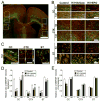Enhanced oligodendrogenesis and recovery of neurological function by erythropoietin after neonatal hypoxic/ischemic brain injury
- PMID: 20360553
- PMCID: PMC2919308
- DOI: 10.1161/STROKEAHA.109.570325
Enhanced oligodendrogenesis and recovery of neurological function by erythropoietin after neonatal hypoxic/ischemic brain injury
Abstract
Background and purpose: Neuronal replacement has recently gained attention as a potential therapeutic target under ischemic conditions. However, the oligodendrogenic infrastructure is equally critical for restoration of brain function and is also sensitive to ischemic injury. Erythropoietin (EPO) is a neuroprotective molecule that stimulates neuronal replacement after neonatal hypoxia/ischemia (H/I) when delivered soon after the onset of reperfusion. Because EPO can improve recovery of neurological function in the absence of tissue protection, we hypothesize that EPO may improve neurological function via enhancement of white matter recovery after H/I. Thus, we sought to determine the effects of delayed administration of EPO on white matter injury and recovery of neurological function after neonatal H/I.
Methods: EPO (1000 U/kg) was injected intraperitoneally at multiple time points beginning 48 hours after H/I in postnatal day 7 rats. The effects of EPO on oligodendrogenesis, white matter injury, and neurogenesis were evaluated using bromodeoxyuridine incorporation and cell-specific immunohistochemistry. Neurological function was assessed by sensorimotor behavioral tests.
Results: Delayed administration of EPO was incapable of reducing brain volume loss but significantly increased oligodendrogenesis and maturation of oligodendrocytes and attenuated white matter injury after H/I. These effects occurred concurrently with enhanced neurogenesis. Delayed EPO treatment improved behavioral neurological outcomes 14 days after H/I injury.
Conclusions: Our study demonstrates that delayed administration of EPO promotes oligodendrogenesis and attenuates white matter injury concurrently with increased neurogenesis. These effects likely contribute to the observed improvement in neurological functional outcomes.
Figures




Comment in
-
White matter protection by erythropoietin: an emerging matter in the treatment of neonatal hypoxic-ischemic brain injury.Stroke. 2010 Nov;41(11):e595; author reply e596. doi: 10.1161/STROKEAHA.110.590844. Epub 2010 Sep 30. Stroke. 2010. PMID: 20884868 No abstract available.
References
-
- Pantoni L, Garcia JH, Gutierrez JA. Cerebral white matter is highly vulnerable to ischemia. Stroke. 1996;27:1641–1646. discussion 1647. - PubMed
-
- Mandai K, Matsumoto M, Kitagawa K, Matsushita K, Ohtsuki T, Mabuchi T, Colman DR, Kamada T, Yanagihara T. Ischemic damage and subsequent proliferation of oligodendrocytes in focal cerebral ischemia. Neuroscience. 1997;77:849–861. - PubMed
-
- Iwai M, Cao G, Yin W, Stetler RA, Liu J, Chen J. Erythropoietin promotes neuronal replacement through revascularization and neurogenesis after neonatal hypoxia/ischemia in rats. Stroke. 2007;38:2795–2803. - PubMed
-
- van der Kooij MA, Groenendaal F, Kavelaars A, Heijnen CJ, van Bel F. Neuroprotective properties and mechanisms of erythropoietin in in vitro and in vivo experimental models for hypoxia/ischemia. Brain Res Rev. 2008;59:22–33. - PubMed
Publication types
MeSH terms
Substances
Grants and funding
LinkOut - more resources
Full Text Sources
Other Literature Sources
Molecular Biology Databases
Research Materials

